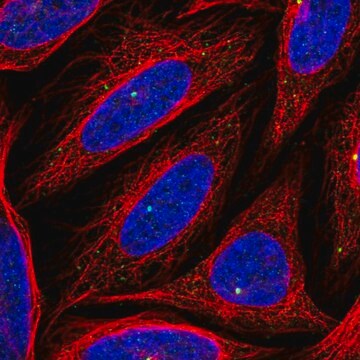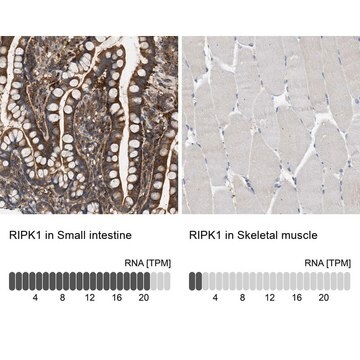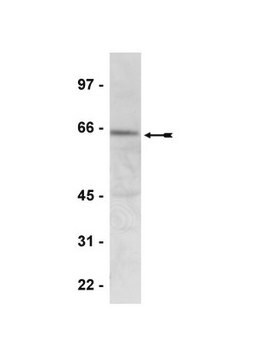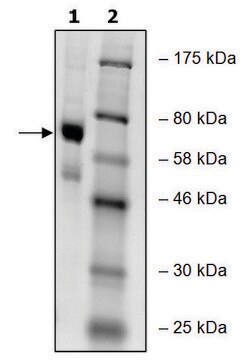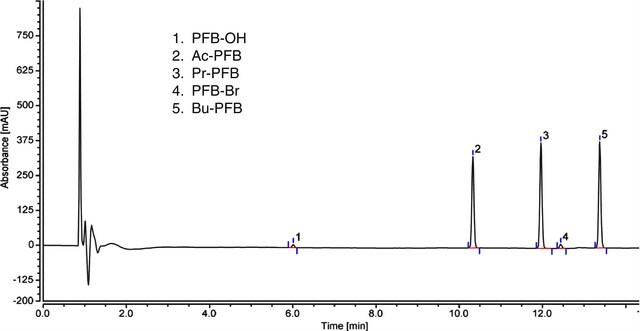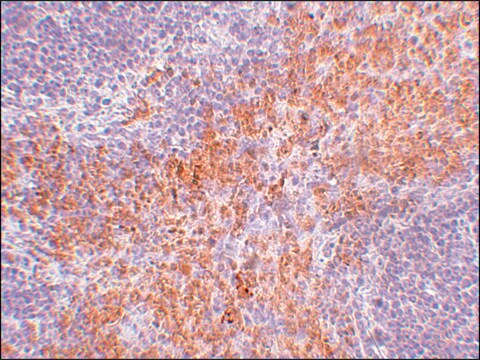推薦產品
生物源
rabbit
品質等級
抗體表格
purified antibody
抗體產品種類
primary antibodies
無性繁殖
polyclonal
物種活性
human
技術
immunocytochemistry: suitable
western blot: suitable
同型
IgG
NCBI登錄號
UniProt登錄號
運輸包裝
ambient
目標翻譯後修改
unmodified
基因資訊
human ... CEP164(22897)
一般說明
Centrosomal protein of 164 kDa (UniProt: Q9UPV0; also known as Cep164) is encoded by the CEP164 (also known as KIAA1052, NPHP15) gene (Gene ID: 22897) in human. Cep164 is expressed in several cell lines and it plays a role in microtubule organization and/or maintenance for the formation of primary cilia (PC), a microtubule-based structure that protrudes from the surface of epithelial cells. Cep164 localizes specifically to very distally located appendage structures on the mature centriole from which PC formation originates and it persists at centrioles throughout mitosis. Hence, it can serve as a marker for distal appendages on mature centrioles or basal bodies. Cep164 also plays a vital role in G2/M checkpoint and nuclear divisions. It is a key participant in the DNA damage-activated ATR/ATM signaling cascade and is required for the proper phosphorylation of H2AX, replication protein A, and check point kinases 1 and 2. Its phosphorylation at Ser186 is induced upon DNA-damage caused by treatment with IR irradiation, UV irradiation, hydroxyurea or amphidicolin. Mutations in CEP164 gene are known to cause nephronophthisis, a disease characterized by blindness in childhood, facial dysmorphism, bronchieclasis, liver failure and progression to end-stage renal failure.
特異性
This polyclonal antibody detects Centrosomal protein of 164 kDa in human. It targets an epitope within the first 298 amino acids from the N-terminal region.
免疫原
Epitope: N-terminus
His-taggged recombinant fragment of the first 298 amino acids from human Centrosomal protein of 164 kDa (CEP164).
應用
Anti-CEP164, Cat. No. ABE2621, is a highly specific rabbit polyclonal antibody that targets Centrosomal protein of 164 kDa and has been tested in Immunocytochemistry and Western Blotting.
Immunocytochemistry Analysis: A representative lot detected CEP164 in U2OS cells and hTERT-RPE1 cells that were serum starved for 48 hours (Graser, S., et. al. (2007). J Cell Biol. 179(2):321-30; Sonnen, K.F., et. al. (2012). Biol Open. 1(10):965-76).
Western Blotting Analysis: A representative lot detected CEP164 in total lysates of HeLa S3, U2OS, and 293T cells as well as 293T cells overexpressing myc-Cep164 (Graser, S., et. al. (2007). J Cell Biol. 179(2):321-30).
Western Blotting Analysis: A representative lot detected CEP164 in total lysates of HeLa S3, U2OS, and 293T cells as well as 293T cells overexpressing myc-Cep164 (Graser, S., et. al. (2007). J Cell Biol. 179(2):321-30).
Research Category
Epigenetics & Nuclear Function
Epigenetics & Nuclear Function
品質
Evaluated by Western Blotting in U2OS cell lysate.
Western Blotting Analysis: A 1:500 dilution of this antibody detected CEP164 in 10 µg of U2OS cell lysate.
Western Blotting Analysis: A 1:500 dilution of this antibody detected CEP164 in 10 µg of U2OS cell lysate.
標靶描述
~200 kDa observed; 164.31 kDa calculated. Uncharacterized bands may be observed in some lysate(s).
外觀
Protein A purified
Format: Purified
Purified rabbit polyclonal antibody in buffer containing 0.1 M Tris-Glycine (pH 7.4), 150 mM NaCl with 0.05% sodium azide.
儲存和穩定性
Stable for 1 year at 2-8°C from date of receipt.
其他說明
Concentration: Please refer to lot specific datasheet.
免責聲明
Unless otherwise stated in our catalog or other company documentation accompanying the product(s), our products are intended for research use only and are not to be used for any other purpose, which includes but is not limited to, unauthorized commercial uses, in vitro diagnostic uses, ex vivo or in vivo therapeutic uses or any type of consumption or application to humans or animals.
未找到適合的產品?
試用我們的產品選擇工具.
儲存類別代碼
12 - Non Combustible Liquids
水污染物質分類(WGK)
WGK 1
分析證明 (COA)
輸入產品批次/批號來搜索 分析證明 (COA)。在產品’s標籤上找到批次和批號,寫有 ‘Lot’或‘Batch’.。
Thao P Phan et al.
Genes & development, 36(11-12), 718-736 (2022-07-01)
Centrosomes are microtubule-organizing centers comprised of a pair of centrioles and the surrounding pericentriolar material. Abnormalities in centriole number are associated with cell division errors and can contribute to diseases such as cancer. Centriole duplication is limited to once per
我們的科學家團隊在所有研究領域都有豐富的經驗,包括生命科學、材料科學、化學合成、色譜、分析等.
聯絡技術服務